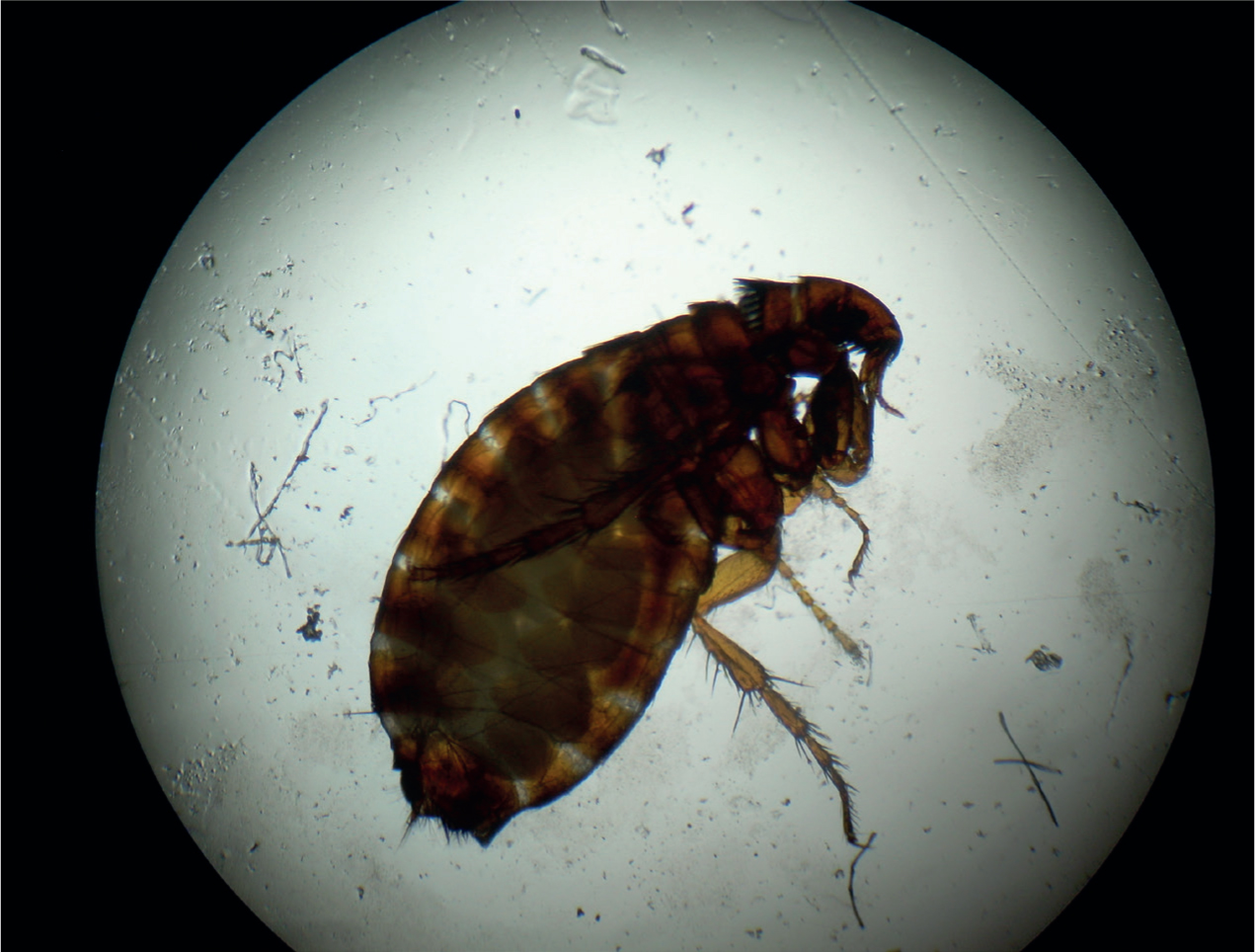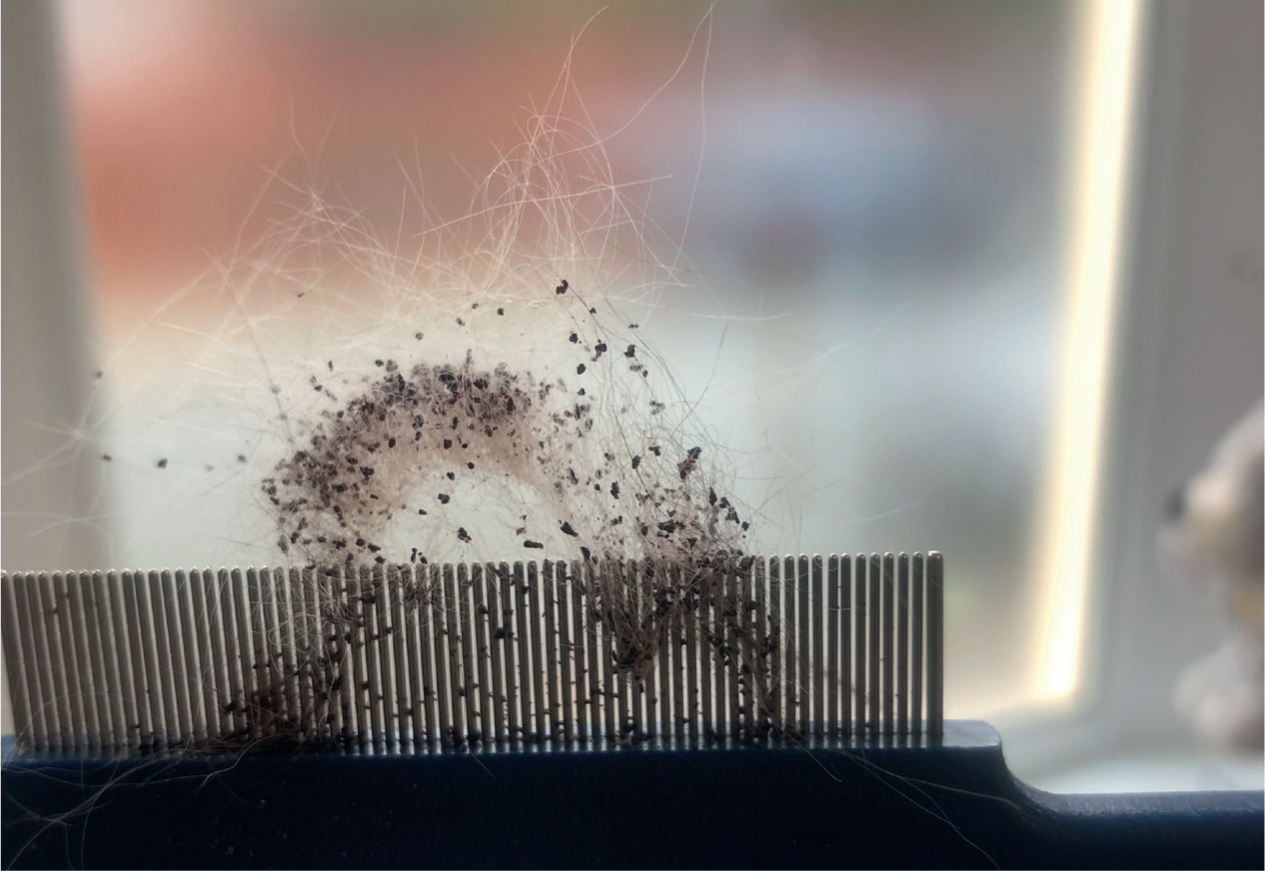Cat fleas (Figure 1) can live on a wide variety of mammalian hosts including cats, dogs, rabbits and wildlife, such as foxes and hedgehogs (Clark et al, 2018). They are also well suited to living in the humidity and temperatures maintained in most UK homes, with 95% of a typical flea infestation existing in the home as eggs, larvae and pupae. This combination of factors leads to increased flea challenge on domestic pets and without routine preventative treatment, there is a high risk of flea infestations establishing (Coles and Dryden, 2014). Cat fleas are present across the UK with the potential for any cat and dog to be exposed with subsequent household infestation. This risk means year round flea control is important to prevent owner irritation, flea allergic dermatitis in pets and the risk of zoonotic pathogen exposure in owners. Recent studies have also, however, demonstrated environmental contamination with compounds present in some flea preventative products, so any control programmes using year round flea control should do so while minimising environmental contamination. Veterinary nurses play a key role in communicating these risks to clients and maximising product administration compliance.

The need for year round flea control
Fleas are a cause of allergic dermatitis and vectors for a variety of infections including Bartonella henselae (cause of cat scratch disease), Rickettsia felis (cause of spotted fever), Haemoplasma spp. (cause of feline infectious anaemia) and Dipylidium caninum tapeworms. With the exception of Haemoplasma spp., all of these infections have zoonotic potential. Fleas may be brought into homes mechanically by humans or by infested cats and dogs moving from household to household. No UK cat and dog is therefore free from the risk of exposure and given the zoonotic risk infestations pose and the risk to feline and canine health, adequate routine flea control is essential for all UK domestic cats and dogs. Cat fleas are present throughout the UK and there are currently no lifestyle risk factors that have been ideinitifed that significantly reduce the risk of household infestations establishing (Abdullah et al, 2019).
The most important aspect of flea control is to ensure adult fleas are killed on the pet before they can initiate egg production. Treatment of the environment with insect growth regulators, environmental insecticides, hot washing of bedding and daily vacuuming is also important to reduce environmental larvae and eggs. Reducing pupal numbers in the environment is difficult, however, making effective, rapid killing of adults essential. Adult fleas can lay eggs within 24 hours so the adulticide chosen must kill fleas at least within that time. They must also be administered frequently enough to continue to prevent flea egg laying. The time after application of the adulticide at which fleas survive long enough to lay eggs is known as the ‘reproductive break point’. If the reproductive break point is reached, then flea control will fail. Even if egg laying is prevented, heavy infestations of fleas may still take at least 3 months to eliminate, even when environmental treatment is used (Dryden et al, 2000). Use of an effective adulticide frequently enough to prevent egg laying year round will prevent infestations and subsequent pathogen and flea bite exposure.
Environmental contamination
Concerns have been raised regarding environmental contamination in relation to routine adulticide use. Recent studies have raised the possibility that significant quantities of fipronil and imidacloprid used in topical flea products may be passing into UK waterways from treated pets (Perkins et al, 2020). A study in Germany found that a significant amount of the imidacloprid pollution measured in streams originates from sewage treatment plants, suggesting an urban origin. Contamination with insecticides is a concern because of the subsequent impact on wider insect populations, and these studies suggest that at least some of this contamination comes from flea treatment products. The widespread use of fipronil and imidacloprid in agriculture and domestic situations for pest control, however, makes the amount of relative contribution difficult to quantify. Even after, fipronil and imidacloprid use was limited in agriculture, it is likely that significant stock piles remain. The source of fipronil and imidacloprid in UK waterways therefore urgently requires further research. In the meantime, veterinary practices have an important role to play in limiting potential contamination, while ensuring households are protected from flea infestations. Measures to reduce environmental contamination while recommending year round flea treatment include:
- Correct application — through demonstrating to clients how to apply products, applying them for them and establishing client preference for spot on, tablet or collar application
- Following data sheet guidance — to avoid products being washed off after application or collars being lost if applied incorrectly
- Responsible disposal of packaging and unused product — owners should bring unused product back to the practice for disposal and not litter used pipettes and packaging
- Product selection based on risk of contamination — taking lifestyle factors into account such as frequent shampooing or pets regularly losing collars will help to select a product for the pet suited to their lifestyle. There is currently insufficient evidence to select a product on the basis of current environmental contamination as only two compounds (fipronil and imidacloprid) have been investigated in independent peer-reviewed studies, and even in these, the extent to which pet products are contributing is unknown. While it has been speculated that spot on products may be more contaminating than oral products, it is still largely unknown to what extent product is eliminated in the faeces.
The role of the veterinary nurse in improving compliance and education
Collecting information from clients relevant to parasite control and giving advice based on that information, is a crucial role of the veterinary nurse as part of the whole practice team. Where multiple veterinary nurses are involved in this role, it is vital advice and protocols are standardised. Knowledge should be kept up to date as parasitology is a rapidly developing field with many relevant research papers and articles published each year. The following questions are examples of what questions clients should be asked in relation to flea control, to ascertain the best flea control product to be used on their pets:
- When was the pet last treated and with what? This helps the veterinary nurse establish when the pet is next due for treatment. Drug interactions or overdose can occur if there is overlap from product use containing the same active ingredients or from the same class. This can also occur if separate flea and worm products are used, e.g. imidacloprid/moxidectin spot on with milbemycin oxime/praziquantel tablets. Careful questioning of which product was used and when, as well as knowledge of drug types, is therefore needed.
- Has the pet had any previous reactions to treatment? The same product or one of a similar formulation can then be avoided. Even if reactions are perceived rather than real, fear of the same reaction happening again can reduce client compliance in administering the product.
- Does the client prefer a specific product formulation? Are they familiar with administering tablets, spot-ons etc? The client needs to feel confident in how they administer the product, and this will reduce spillage onto hands and directly into the environment.
- Does the pet enjoy going swimming and is he/she regularly bathed? Efficacy of products that are absorbed into the sebum layer, e.g. fipronil and imidacloprid, are affected by shampoos and swimming. If clients use these products and continue to allow their pet to swim or bath them regularly, this can lead to poor compliance because of a perceived lack of efficacy. It will also likely lead to increased environmental contamination, especially if shampooing occurs within the time advised against in data sheets.
- Does the client have other pets? All pets within the household should be treated, animals that do not go outside can still be infested via parasites brought in by other animals or the client.
- What other parasites require preventative treatment? Depending on the lifestyle of the pet and local geographic risk, preventative treatments for other parasites may be required. In these cases, endectocides can be useful in reducing the number of products clients have to give and potentially improving compliance as a result.
Having established which parasite preventative products are required, engagement with clients is essential to ensure products are used correctly and at the correct frequency. Recognising the value of treatments, cost and remembering to administer them are all barriers to effective compliance and control.
- Recognising value — explaining the reasoning behind the decision to use a preventative treatment is important to emphasise to clients the importance of the treatment being recommended. Sales of parasiticides without explanation can lead to disenfranchisement and even if products are purchased, they may not be used. Social media, waiting room posters and practice websites are useful to educate owners, with information taking the form of diagrams, videos and infographics. Checking for fleas routinely as part of health examinations (Figure 2) will also help to demonstrate to owners when infestations are present and look at why current flea control is failing. ESCCAP UK & Ireland now has a flea ID poster which can be used to demonstrate different types of fleas to clients and what they look like. This can be downloaded from ESCCAP UK & Ireland: https://www.esccapuk.org.uk/parasite-id-posters-uk/.
- Cost — cost can be a barrier to clients purchasing appropriate treatments and may drive clients towards buying cheaper products through alternative channels, where advice on their use may be limited. Cost can be reduced through the use of practice plans, discounts for regular use or other schemes for spreading the cost of purchase. Emphasising the cost of treating potential skin disease in untreated cats and dogs compared with the predictable spread cost of routine treatments is also worthwhile.
- Compliance — establishing preference for spot-on, tablet or collar preparations will encourage clients to use preventative products and increase the likelihood of them being administered correctly. Demonstrating how to apply products in practice is also helpful in improving correct usage. Reminder alerts by text, email or app will help in reminding clients when to administer treatments.

Listening closely to the client and showing a genuine interest in what they have to say is just as important as asking the correct questions. A client who feels their opinions are valued is more likely to utilise advice given (Maddison et al, 2021).
Conclusions
The ubiquitous nature of flea risk and infestations makes routine preventative treatment in all UK cats and dogs essential to limit zoonotic risk and maintain pet health. It is important, however, to minimise environmental contamination while achieving this. This can be achieved through owner education and engagement leading to appropriate product selection based on lifestyle and preference. Demonstrating how to effectively apply product and follow data sheet guidance will also improve efficacy but also limit environmental contamination through product being washed off into water courses. The veterinary nurse plays a vital role in client bonding and education in the practice setting. Without it clients suffering with household flea infestations will purchase flea products through non veterinary channels, often without any education on their use. As a result, environmental contamination will increase through misuse and flea control fail.
KEY POINTS
- Fleas are ubiquitous with all UK cats and dogs at risk of exposure.
- The zoonotic and animal health risks posed by flea household infestations justifies routine preventative flea treatment for all UK cats and dogs.
- There is some evidence for environmental contamination with flea products in the UK. As such, products should be selected on the basis of owner lifestyle and preference to increase compliance and reduce environmental contamination.
- Veterinary nurses are key in educating clients and engaging with them to maximise compliance.
- Flea infestations are a reality and if treatment gaps are allowed to occur and infestations result, then clients may purchase control products through non veterinary channels.
- If this is accompanied with no advice then it is likely to lead to poor compliance and increased environmental contamination.


